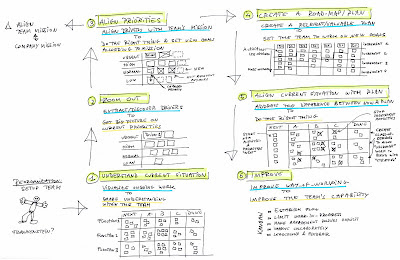My current customer went through a re-organization of the whole IT department in search for a faster, more value-centered IT. The ambition looks great on paper and the future will tell if it helped. Anyway, a lot of teams were disolved and new teams were formed in the wake of the change. These new teams typically look like Frankenstein’s creature: a bunch of people coming from various now-defunct functions, loosely and hastely knit together.
This is tricky, after all not so long ago these people didn’t even have the same goals and purpose. Moreover, everyone still has a huge luggage full of stuff-to-do that is directly related to the ‘old’ function; without anything in common with these other people that one is supposed to be working with.
Now, the problem is how to quickly create a fully-functioning and healthy body from these parts: a Team. That is to say an environment where team members help each others to reach clear common goals in line with the organization’s vision. Time is, of course, critical as the new organization has tremendous expectations to live up to: no time can be lost to a slow an organic recovery. Something more, something smart is required.
I would like to present how we are doing this today (with great results as I see it). I am using, of course, a combination of Kanban and User Story Mapping to quickly transition the new group from Frankenstein’s creature to a Team. The illustration below should be self explaining, but here are some of the keys.
- Use visualization to share an understanding of what is happening – and why – with everyone on the team.
- Start by using one swim-lane per “old” function. This makes the “luggage” very visible and it acknowledges that there are still stuff to do that are directly related to these old functions.
- Create a “common” swim-lane where one can place new work directly related to the new team, or lift existing work within the old functions that is directly related to the purpose of the new team.
- Make what drives the work explicit (the “drivers“) to get a overall picture of the current priorities (which are yet still very much tainted by the “old” functions).
- Have a workshop to align priorities: to add, remove drivers and re-prioritize the existing drivers. Use the organization’s vision and goals, and potentially the expectations put on the new team, to do that.
- Now, create a road-map using User Story Mapping: break down each driver into small independants elements from less optional to more optional, then create increments (releases?!).
- Align the current situation with the plan (actually, the first increment): stop what has become irrelevent, start new activities (placing them in the ‘Next’ column). Remove the swimlanes as they have become irrelevent: everyone is now working according to what is ‘right’ for the team. Instead, use swim-lanes to create class-of-services.
- Improve: now we are ready to use Kanban to improve the team’s capability!




